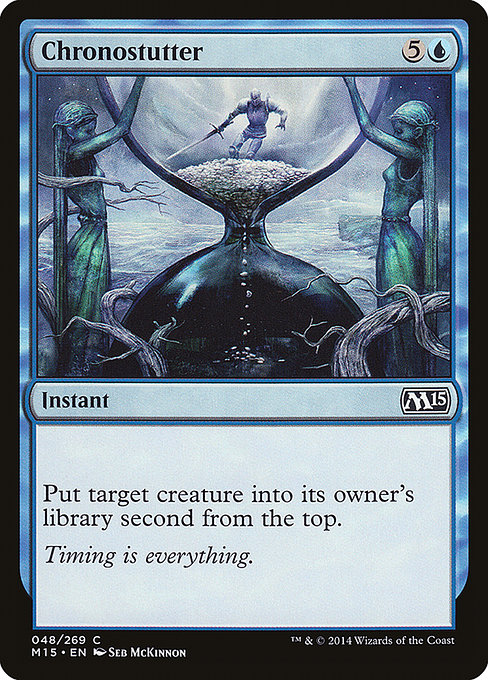
Image courtesy of Scryfall.com
Bold design risks that paid off in MTG: a closer look at Chronostutter
In the grand tradition of blue's love affair with time and tempo, Chronostutter stands out as a bold gamble from the Magic 2015 core set. For a color discipline obsessed with controlling the pace of a duel, the card leans into a tempo-killer’s dream: spend a substantial mana investment to manipulate what your opponent draws and when. The result is a memorable single-minded moment that, on paper, looks like an overreach for a common instant. In practice, it became a touchstone for what bold design can look like when a set asks players to reimagine how time interacts with combat and card advantage. 🧙♂️🔥
The card is an instant with a hefty mana cost of {5}{U}, a rarity that betrays its ambition, and a flavor text whispering, “Timing is everything.” The flavor text anchors the feel of the moment: sometimes you don’t win by brute force, you win by predicting the turn and nudging probability in your favor. The 2015 frame and Seb McKinnon’s evocative art reinforce this mood—blue’s staunch guardianship of the moment, captured in a single, deliberate moment of time being rearranged. The decision to print a six-mana instant as a common card was, in many circles, a design risk. Could a spell this niche—one that doesn’t wipe the board or generate card advantage outright—carry the weight of a core-set card? The answer, for many players, was an emphatic yes. 🎨
The mechanics that sparked conversation
- Targeted library manipulation: Chronostutter puts a chosen creature into its owner's library second from the top. It’s not a removal spell in the traditional sense, but it reshapes the future draws for an opponent in a way that’s both subtle and tangible. It’s a rare creature-shove that doesn’t remove a threat permanently, yet shifts the timeline of the game by a meaningful margin. ⚔️
- High cost, high payoff in long games: The {5}{U} price tag discourages casual use, nudging players toward patient games where blue can grind down a plan and then surprise an opponent with a precisely timed disruption. In longer matches, that extra couple of turns can be the difference between a win on the back of a counterspell and a board stall that secures inevitability. 🔥
- Common rarity, core-set placement: Printing this effect at common within a core set signaled Wizards’ willingness to experiment with unusual angles for blue’s time manipulation. It wasn’t about a flashy finisher; it was about a design philosophy that rewards strategic patience and clever timing rather than brute force. 💎
Flavor and feel matter as much as raw power. Chronostutter’s name evokes a moment when the clock tilts, when a threat is nudged from the battlefield to the top of the library, and the game’s rhythm shifts as if the hands on a clock suddenly snap forward. Timing is everything.
Art, identity, and the psychology of tempo
Seb McKinnon’s illustration anchors the card in mood more than in spectacle. The image invites you to lean into the moment: a blue figure, poised between time’s tremor and control, ready to flip the board’s tempo with a single decision. The artistry mirrors the design: it’s not about a dramatic moment of destruction; it’s about a quiet, almost surgical adjustment to fate. Artists and designers collaborated here to deliver a card that feels like a hinge—one that can shift a match’s axis with precision. The art’s emotional resonance helps players remember why tempo matters in MTG, even when the spell itself looks understated on the surface. 🎨
Practical takeaways for today’s formats
In contemporary play, Chronostutter isn’t a core pillar of any top-tier archetype, but its value lies in its teaching: sometimes you win by buying time rather than by overpowering your opponent. For modern and pioneer players who value card-advantage engines and control themes, it’s a reminder that tempo disruption can come from surprising angles. In low-to-mid power environments, a single timely shuffle of a critical threat to the top of the library can buy you a window to draw a answer-based answer or land a victory through a stabilized board state. And for casual or kitchen-table formats, Chronostutter invites creative outplays—targeting a key beater or a recurring bomb to push the game into a more favorable late stage. 🧙♂️⚔️
Beyond the gameplay, Chronostutter illustrates a core design philosophy: give players a choice that isn’t about brute removal but about steering outcomes. The card’s enduring memory in the MTG community comes from that moment of decision—the calculation that makes a six-mana spell feel worth the investment because the payoff is a shift in the game’s tempo at the exact right moment. The synergy with other library or draw-order tricks—while not the centerpiece of a dedicated archetype—remains a tantalizing thought experiment for future design. 🎲
Collectibility, value, and the design legacy
- Print in Magic 2015 as a common, with foil versions available, marking a counterintuitive celebration of flavor and mechanics at common rarity. Rarity isn’t always a guarantee of power; it’s a philosophy about how players experience a card’s impact in play.
- The card sits at a crossroads of strategy and curiosity: it’s easy to overlook, but when the moment hits, the effect feels surprisingly decisive. This is where design risk morphs into design payoff—the kind of card that players remember and discuss long after the match ends. 💎
- Critically, the card’s design invites us to think about what counts as “removal” in MTG—how tempo, gravity, and time can be wielded as effectively as a literal remove-from-board spell. The result is a timeless conversation about how bold ideas can become lasting staples in players’ minds. 🧠